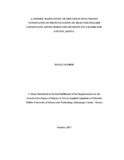| dc.description.abstract | The aim of this study was to investigate the influence of Lutsotso consonants on
pronunciation of selected English consonants among Form One Students, learning
English as a second language (ESL), in Lurambi Sub-County, Kakamega County,
Kenya. The selected English language consonant sounds were: plosives /p/, /b/, /t/,
/d/, /k/, /g/, fricatives /f/, /v/, /θ/, /ð/ and affricates /t∫/, /ʤ/ only. The objectives of
the study were to examine the influence of the Lutsotso consonants on pronunciation
of selected English consonants, establish the impact of home environment on
pronunciation of selected English consonants and establish the effect of gender on
pronunciation of selected English consonants. The study was anchored on Larry
Selinkers’ Transfer theory which states that: the learner’s first language will
positively or negatively affect second language acquisition (SLA). A correlation
research design was adopted to establish and describe the nature of the relationship
that exists between independent variables and dependent variable. The study
purposively sampled out nine mixed gender, public day secondary schools out of the
thirteen schools in the Sub-County. The target population was seven hundred and
twenty respondents, with a sample size of seventy two respondents’ selected using
simple random sampling. For gender equality, a proportionate number of males and
females were selected using proportionate stratified sampling using a proportionate
of ten percent of the population of each school. The study collected data using
dictation, an oral task and a questionnaire for the respondents. Qualitative data was
analyzed descriptively whereas quantitative data was analyzed using inferential
statistics where Analysis of Variance (ANOVA) was used. Data was presented in
tables and charts, followed by an explanation. The findings were that Lutsotso
consonant sounds affect the pronunciation of the selected English language plosives
/p/, /b/, /t/, /d/, /k/, /g/, fricatives /f/, /v/, /θ/, /ð/ and affricates/t∫/, /ʤ/. The sounds that
exist in Lutsotso were simpler to articulate whereas those sounds that do not exist
were quite difficult. The female gender was better than the male gender in oral
task and dictation, however in general there is no significant difference.
Respondents in rich literacy h ome environment performed better than those in
low literacy home environment in oral task and dictation. The study would benefit
teachers of English, learners, linguists and would add valuable knowledge to the field
of African Phonology. | en_US |

